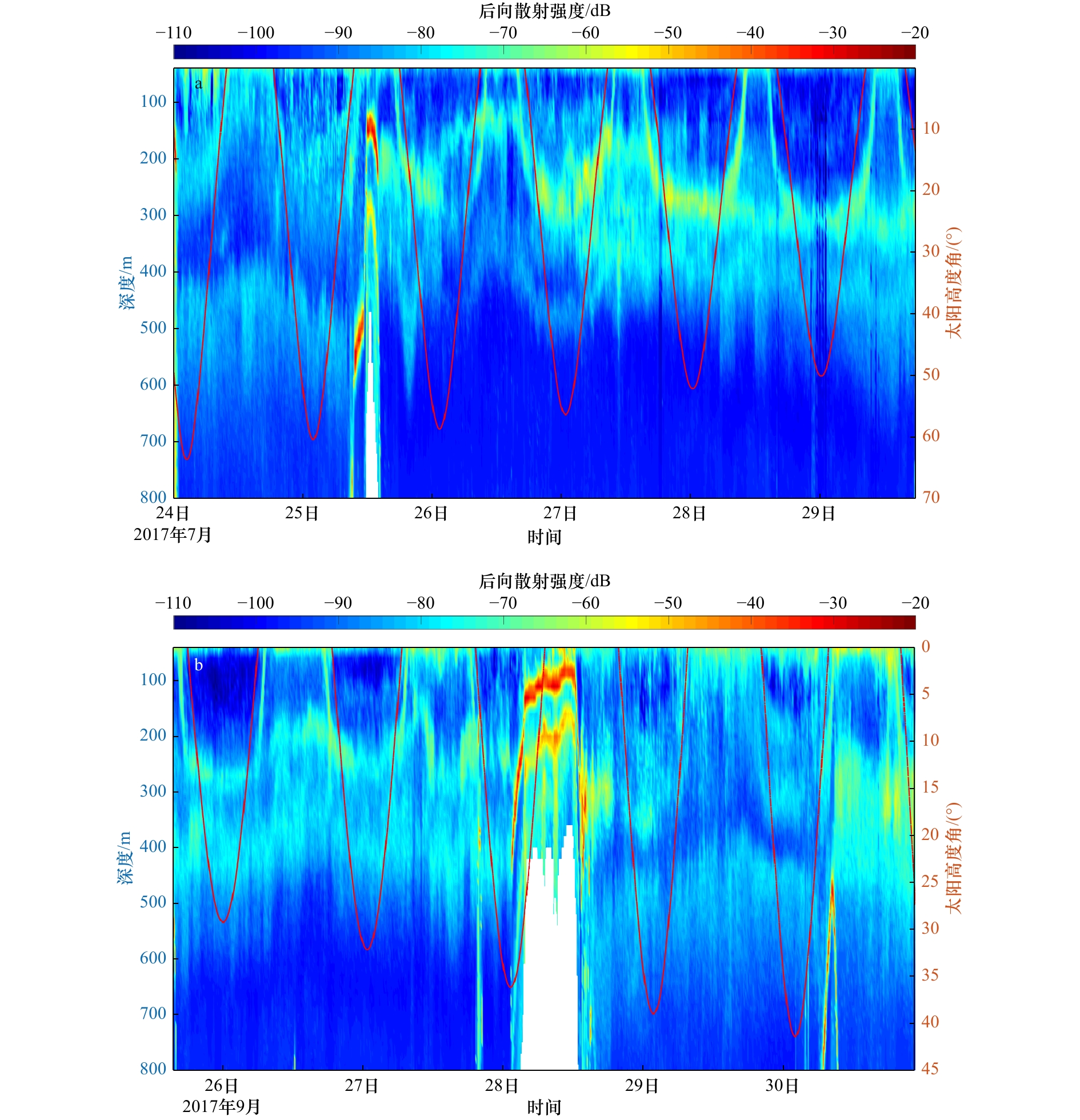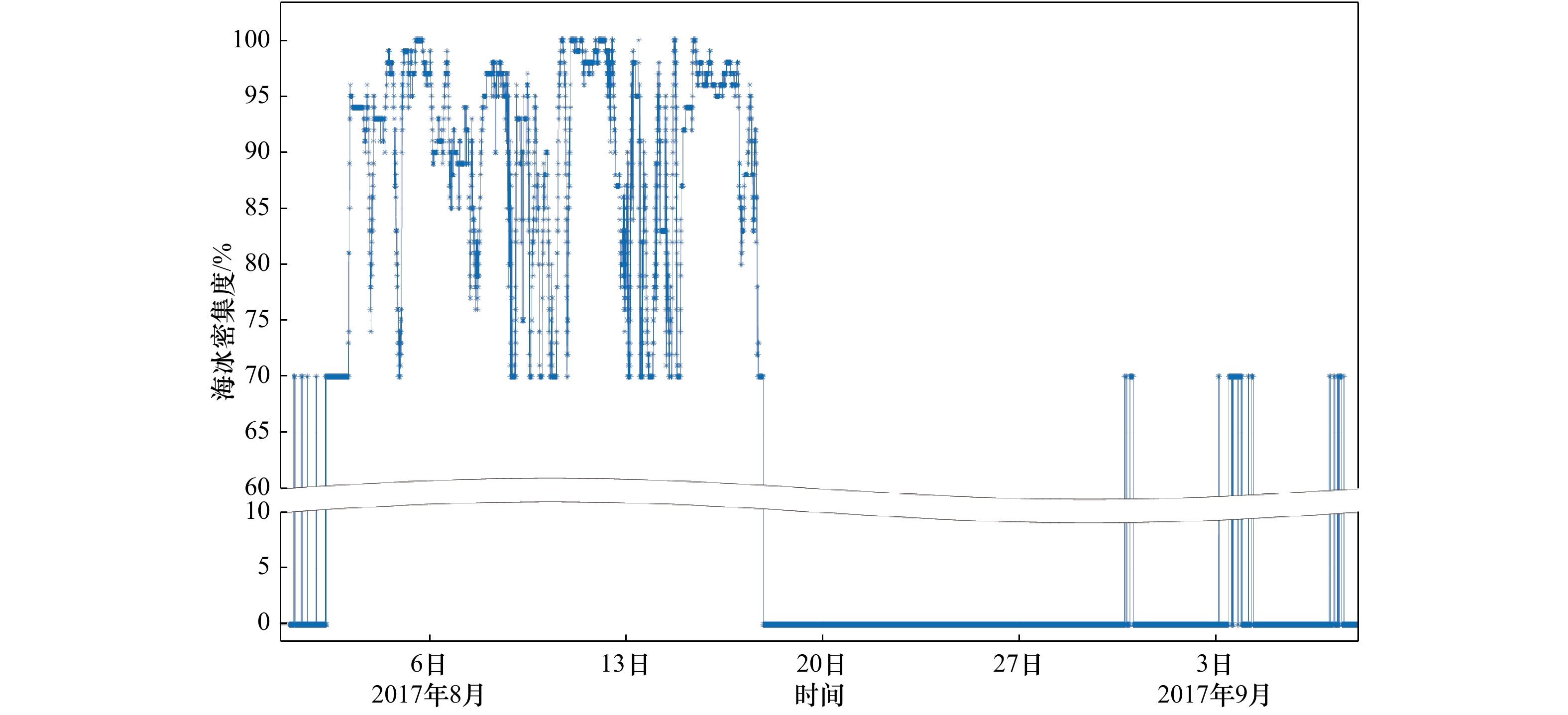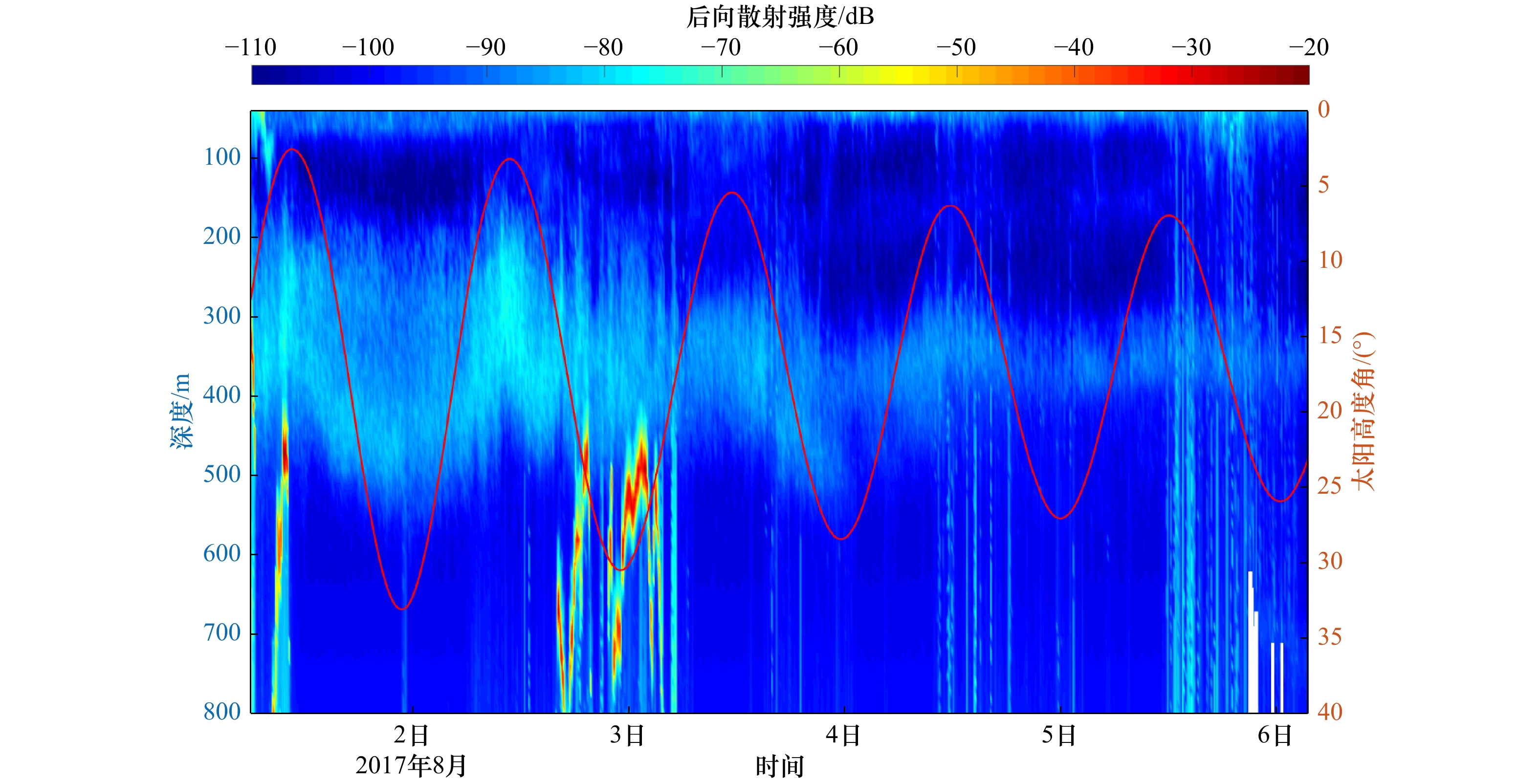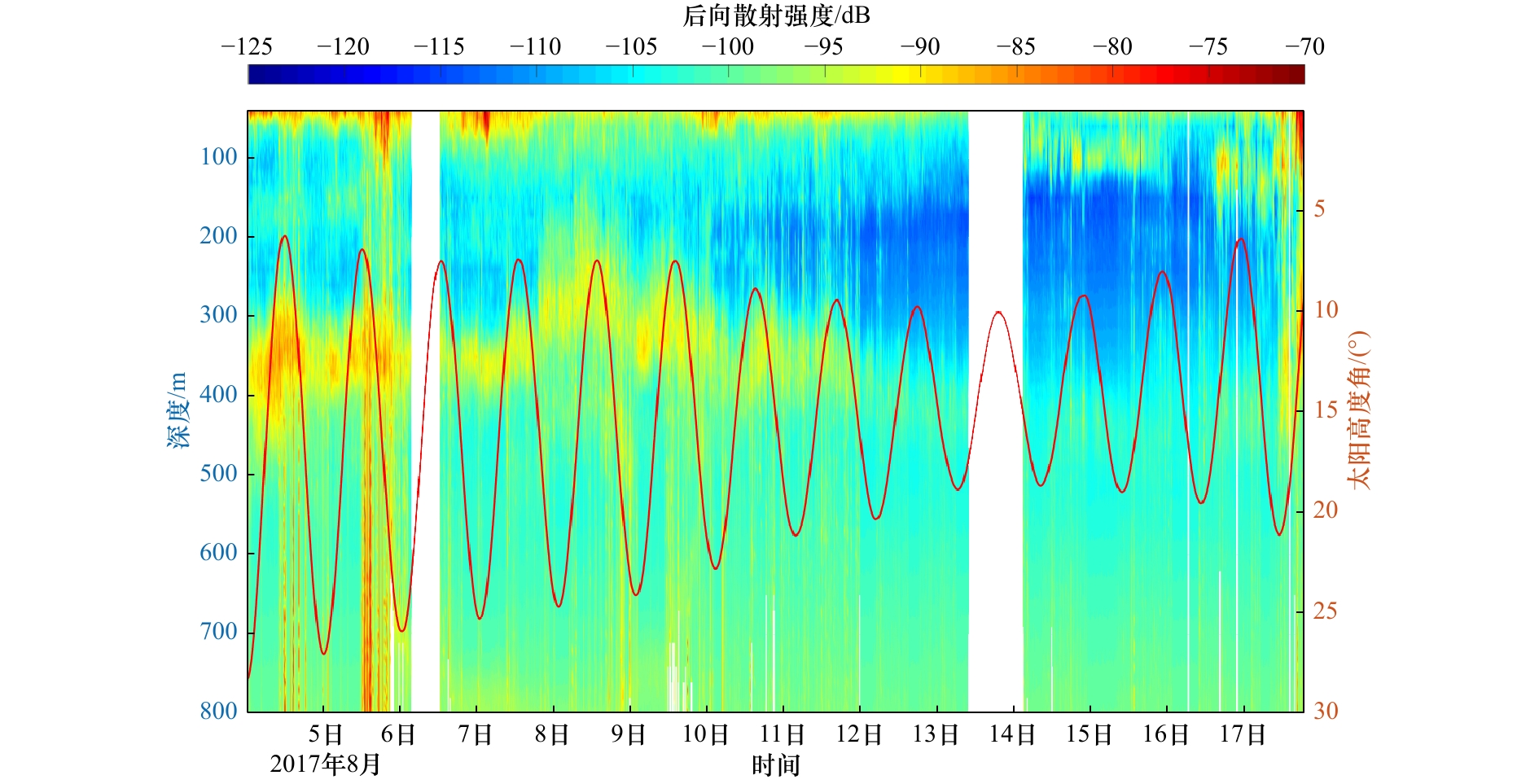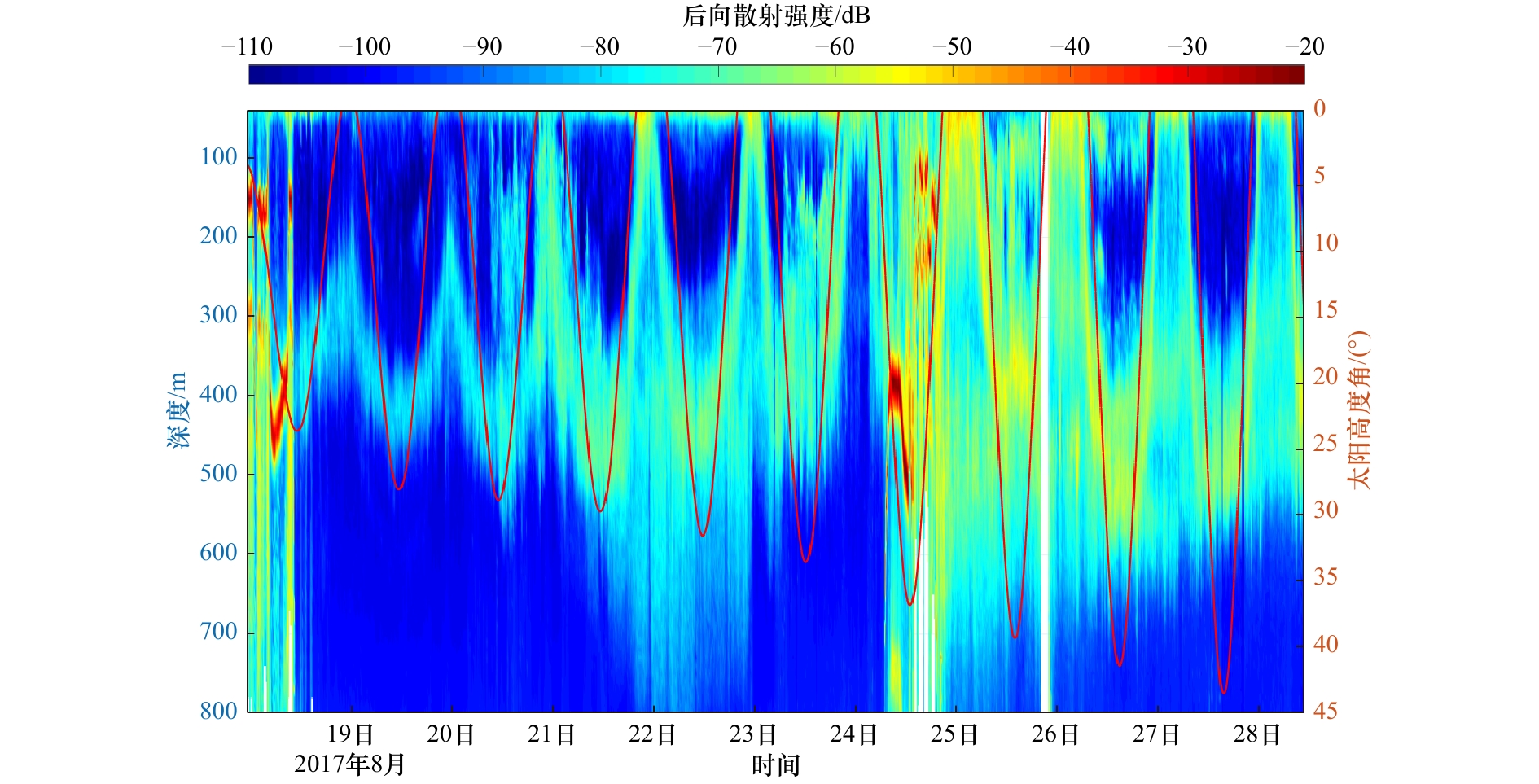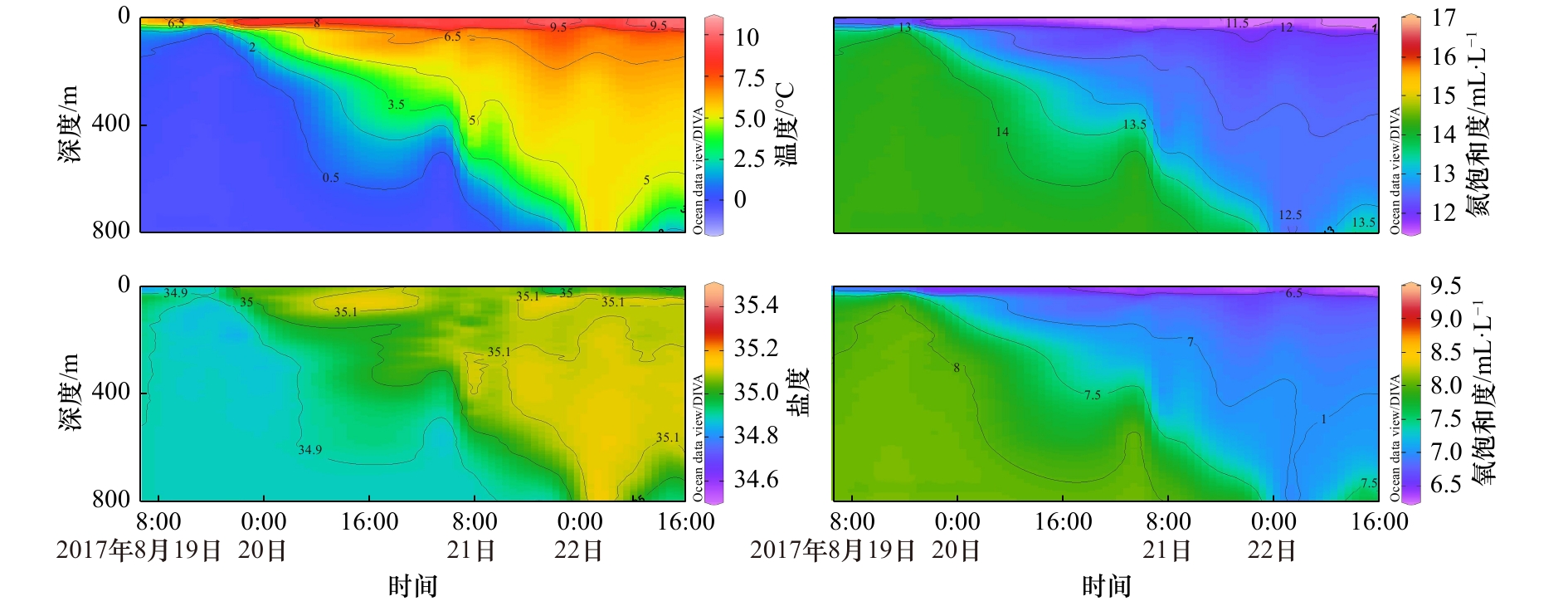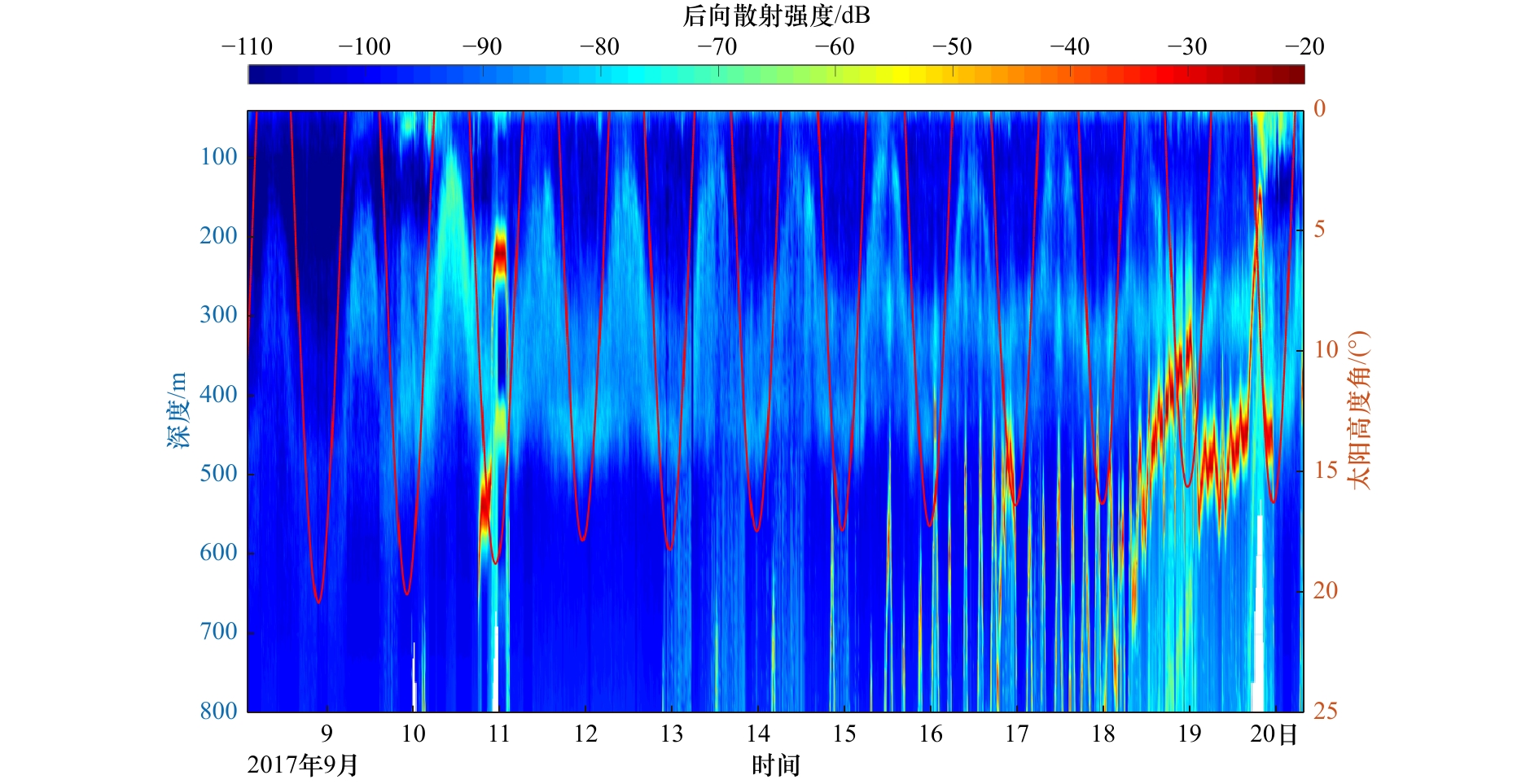Research on the distribution of sound scattering layer in the middle and high latitudes ocean of the Northern Hemisphere in autumn
-
摘要: 利用第八次北极调查走航ADCP后向散射强度数据,结合太阳高度、海冰密集度和实测水体环境参数数据,统计分析了中高纬海洋声散射层的时空变化特征。结果表明,纬度越高,声散射层在海表滞留时间越短,即使在极昼期间及全海冰覆盖海域,虽然其迁移幅度和后向散射强度减弱,但仍受太阳高度变化影响,且二者具有较强的时序相关性;在北极中央海域,不仅声散射层迁移活动较弱,且出现无明显散射层的情况,可能是因为该海域浮游动物和鱼类聚集度相对较低且迁移活动微弱,超出了本文所用ADCP的探测精度范围;从鄂霍次克海至白令海西南海域,往返ADCP数据均显示有两个后向散射强度上高下低,但垂直迁移时间同步的声散射层,且二者间距随纬度增加而逐渐减小并合为一体,这可能是由不同生活习性的海洋生物造成的。Abstract: The shipboard ADCP (Acoustic Doppler Current Profilers) backscatter intensity data in the Eighth Arctic Science Expedition are analyzed for the temporal and spatial characteristics of the sound scattering layer (SSL), by combining the solar altitude, the sea ice concentration and the in-situ data of the water environment parameters. The results show that the higher the latitude is, the shorter the time of the SSL is on the sea surface. Even during the period of polar day and all covered by sea ice, the migration amplitude and backscattering intensity of the SSL are weakened, but they are still affected by the change of the solar elevation, and there is a strong temporal correlation between them and solar altitude angle. In the middle section of the Arctic, the migration of the SSL is weak, and there is no obvious SSL observed, the reason may be that the concentration of zooplanktons and fishes are relatively lower and the migration is weak, which is beyond the accuracy range of ADCP used in this paper. ADCP data in the back and forth from the Okhotsk Sea to the southwest of the Bering Sea, show that there are two SSLs, the shallower depth and the greater backscatter intensity, but their vertical migration time is synchronized, and the spacing between them is gradually reduced and combined as the latitude increases, it may be caused by marine organisms with different life habit.
-
图 1 第八次北极科学考察走航ADCP航迹和CTD站位分布
蓝色线段为ADCP走航航迹,绿色圆点为CTD站位点,红色线段为 本文所用SG、CA、CB CTD断面
Fig. 1 The track of ship-board ADCP and the position of CTD stations in the eighth Arctic science expedition
Blue lines for ADCP track, green dots for CTD stations, red lines for SG, CA and CB sections of CTD in this paper
表 1 全航程声散射层参数统计
Tab. 1 Statistics of the parameters of sound scattering layer for the entire voyage
日期 向下迁移早于日出时差/min 向上迁移晚于日落时差/min 平均深度/m 平均厚度/m 平均强度/dB 备注 7月22日 60 65 380 100 −92 7月23日 80 70 385 100 −90 7月24日 — — 215 110 −81 第一散射层 — — 495 170 −83 第二散射层 7月25日 — — 220 120 −80 第一散射层 — — 480 130 −82 第二散射层 7月26日 50 60 250 120 −72 第一散射层 — — — — — 第二散射层 7月27日 81 73 220 100 −68 第一散射层 — — 480 80 −88 第二散射层 7月28日 85 102 285 130 −68 第一散射层 — — 390 120 −80 第二散射层 7月29日 102 116 305 90 −75 第一散射层 — — — — — 第二散射层 8月2日 极昼,海冰覆盖,散射层迁移未明显到达表层 425 200 −81 8月3日 380 150 −87 8月4日 360 150 −87 8月5日 350 110 −93 8月6日 350 100 −94 8月7日 330 110 −94 8月8日 265 210 −94 8月9日 325 130 −93 8月10日 380 120 −95 8月11日 360 100 −97 8月12日 370 90 −101 8月13日 405 90 −101 -
[1] 孙松. 中国区域海洋学: 生物海洋学[M]. 北京: 海洋出版社, 2012.Sun Song. Regional Oceanography of China Seas: Biological Oceanography[M]. Beijing: China Ocean Press, 2012. [2] 孙栋, 王春生. 深远海浮游动物生态学研究进展[J]. 生态学报, 2017, 37(10): 3219−3231.Sun Dong, Wang Chunsheng. A review of open ocean zooplankton ecology[J]. Acta Ecologica Sinica, 2017, 37(10): 3219−3231. [3] 李少菁, 许振祖, 黄加祺, 等. 海洋浮游动物学研究[J]. 厦门大学学报: 自然科学版, 2001, 40(2): 574−585.Li Shaojing, Xu Zhengzu, Huang Jiaqi, et al. Studies on biology of marine zooplankton in China[J]. Journal of Xiamen University: Natural Science, 2001, 40(2): 574−585. [4] 汪德昭, 尚尔昌. 水声学[M]. 2版. 北京: 科学出版社, 2013.Wang Dezhao, Shang Erchang. Underwanter Acoustics[M]. 2nd ed. Beijing: Science Press, 2013. [5] 李玉昕, 杨颐华, 李志宽, 等. 南海深水散射层的实验研究[J]. 海洋学报, 1986, 8(1): 107−110.Li Yuxin, Yang Yihua, Li Zhikuan, et al. Experimental study of deep scattering layer in South China Sea[J]. Haiyang Xuebao, 1986, 8(1): 107−110. [6] 温明明, 牟泽霖, 万芃, 等. 南海深海体积混响及散射特性试验研究[J]. 声学技术, 2016, 35(6): 512−517.Wen Mingming, Mou Zelin, Wan Peng, et al. Experimental study of deep-sea volume veverberation and scattering characteristics in the South China Sea[J]. Technical Acoustics, 2016, 35(6): 512−517. [7] Walther G R, Post E, Convey P, et al. Ecological responses to recent climate change[J]. Nature, 2002, 416(6879): 389−395. doi: 10.1038/416389a [8] Costello M J, Breyer S. Ocean depths: the mesopelagic and implications for global warming[J]. Current Biology, 2017, 27(1): R36−R38. doi: 10.1016/j.cub.2016.11.042 [9] 刘洪宁. 北冰洋太平洋扇区声学体积后向散射强度和海洋环境噪声研究[D]. 青岛: 国家海洋局第一海洋研究所, 2015.Liu Hongning. Study of acoustic volume backscattering strength and marine environment noise in Pacific sector of the Arctic Ocean[D]. Qingdao: First Institute of Oceanography, State Oceanic Administration, 2015. [10] Deines K L. Backscatter estimation using broadband acoustic Doppler current profilers[C]//Proceedings of the IEEE Sixth Working Conference on Current Measurement. San Diego, CA, USA: IEEE, 1999: 249−253. [11] 龚丽辉, 冯雷, 王长红, 等. 利用声相关流速剖面仪观测深水散射层[J]. 声学技术, 2008, 27(6): 807−811.Gong Lihui, Feng Lei, Wang Changhong, et al. Deep scattering layer observation using acoustic correlation current profiler[J]. Technical Acoustics, 2008, 27(6): 807−811. [12] 张超. 基于多波束测深仪和走航式ADCP的西太平洋声学散射层研究[D]. 青岛: 国家海洋局第一海洋研究所, 2017.Zhang Chao. Research on sound scattering layer in the western Pacific observed with Multibeam sounding system and ship-board ADCP[D]. Qingdao: First Institute of Oceanography, State Oceanic Administration, 2017. [13] 陈次颖, 章淑珍. 应用水声方法考察底栖鱼类和DSL(深海散射层)的垂直移动[J]. 海洋科学, 1994, 18(3): 53−56.Chen Ciying, Zhang Shuzhen. A practical investigation on Demersal fish and DSL rhythmic vertical migration by acoustic method[J]. Marine Sciences, 1994, 18(3): 53−56. [14] Gjøsæter H, Wiebe P H, Knutsen T, et al. Evidence of diel vertical migration of mesopelagic sound-scattering organisms in the Arctic[J]. Frontiers in Marine Science, 2017, 4: 332. doi: 10.3389/fmars.2017.00332 [15] 刘顺会, 孙松, 韩博平. 浮游动物昼夜垂直迁移机理的主要假说及其研究进展[J]. 生态科学, 2008, 27(6): 515−521. doi: 10.3969/j.issn.1008-8873.2008.06.014Liu Shunhui, Sun Song, Han Boping. Hypotheses and theories of mechanisms underlying the diel vertical migration of zooplankton: a review[J]. Ecological Science, 2008, 27(6): 515−521. doi: 10.3969/j.issn.1008-8873.2008.06.014 [16] Kaartvedt S, Røstad A, Aksnes D L. Changing weather causes behavioral responses in the lower mesopelagic[J]. Marine Ecology Progress Series, 2017, 574: 259−263. doi: 10.3354/meps12185 [17] Klevjer T A, Irigoien X, Røstad A, et al. Large scale patterns in vertical distribution and behaviour of mesopelagic scattering layers[J]. Scientific Reports, 2016, 6: 19873. doi: 10.1038/srep19873 [18] Cohen J H, Berge J, Moline M A, et al. Is ambient light during the high arctic polar night sufficient to act as a visual cue for zooplankton[J]. PLoS One, 2015, 10(6): e0126247. doi: 10.1371/journal.pone.0126247 [19] Aksnes D L, Røstad A, Kaartvedt S, et al. Light penetration structures the deep acoustic scattering layers in the global ocean[J]. Science Advances, 2017, 3(5): e1602468. doi: 10.1126/sciadv.1602468 [20] 吕连港, 乔方利, 葛人峰, 等. 后向散射强度与温跃层关系研究[J]. 海洋科学进展, 2003, 21(4): 465−470. doi: 10.3969/j.issn.1671-6647.2003.04.014Lü Liangang, Qiao Fangli, Ge Renfeng, et al. Study on the relationship between backscatter strength and thermocline[J]. Advances in Marine Science, 2003, 21(4): 465−470. doi: 10.3969/j.issn.1671-6647.2003.04.014 [21] Teo S L H, Kudela R M, Rais A, et al. Estimating chlorophyll profiles from electronic tags deployed on pelagic animals[J]. Aquatic Biology, 2009, 5(2): 195−207. [22] Proud R, Cox M J, Brierley A S. Biogeography of the global ocean’s mesopelagic zone[J]. Current Biology, 2017, 27(1): 113−119. doi: 10.1016/j.cub.2016.11.003 [23] Bianchi D, Mislan K A S. Global patterns of diel vertical migration times and velocities from acoustic data[J]. Limnology and Oceanography, 2015, 61(1): 353−364. [24] Berge J, Cottier F, Last K S, et al. Diel vertical migration of Arctic zooplankton during the polar night[J]. Biology Letters, 2009, 5(1): 69−72. doi: 10.1098/rsbl.2008.0484 -





 下载:
下载:



